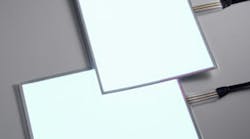In retail stores, there's no doubt space is at a premium. So when New York-based Christian Dior learned about a new flat light source — Light Emitting Capacitor (LEC) technology by Blue Bell, Pa.-based CeeLite — store management was definitely interested in giving it a try.
“We used it in Bloomingdale's for a counter — one of the visuals there — because we didn't really have a lot of space,” says Tarek Tabbal, merchandise manager for Christian Dior's parent company, LVMH Perfumes & Cosmetics. “Usually to build a light box and to use fluorescent tubes, we need at least 6 inches, and we only had 2 or 3 inches. There was no way we could get a light panel unless we used this technology.”
Besides cutting down on the amount of space required, LEC panels also generate no heat — another appealing feature to Christian Dior. “In cosmetics, if you use a fluorescent tube or another type of lighting, it produces heat that's not very good for the product,” Tabbal says. “That's definitely an advantage.”
CeeLite LEC panels, which became commercially available earlier this year, can be as thin as a human hair (less than 0.1 mm thick) and nearly as flexible. Originally designed for backlighting images for advertising purposes, they can be created in any shape and in a wide range of colors, including white light.
“If you look at a typical light box, it is tremendously overpowered, and then to even out the light, a film is used to further diffuse the light so that the final image has a look of consistency,” says Malcolm Hayward, CEO of CeeLite. “Our light form provides 99% surface illumination (i.e., no hot spots), which then enables the media guys to use a film that can be 80% or 90% translucent. So the amount of light required is a lot less.”
An LEC panel's power consumption is about 10 watts-per-square-foot, which Hayward says is very efficient compared with other light forms. Adding to its efficiency is the product's lack of heat. “You can touch it, and there's zero heat,” he says. “That's because we're exciting electrons, as opposed to trying to burn a filament.”
To achieve a flat light sans heat, CeeLite uses a capacitor structure with phosphors — made by Osram Sylvania — sandwiched between the electrodes. Applying AC voltage generates a changing field within the phosphor, which, in turn, causes the phosphors to emit light.
The LEC panels are powered by inverters, which convert DC or AC current to the required voltage and frequency, depending on the desired brightness and size of the panel. The inverters are also programmable and can even be connected and work together to achieve a uniform effect, such as dimming and strobing.
Depending on the LEC panel, the inverter may or may not need to boost the incoming voltage, but it does typically boost the frequency of the signal by quite a bit, says Hayward. “We run frequencies anywhere from 400 Hz to about 1,000 Hz,” he says. “We need those higher frequencies to excite the electrons more than a 60- or 50-Hz cycle would do.”
Despite the LEC panel's paper-thin nature, CeeLite maintains that the product is surprisingly durable. “We put the product through what we call a punch test, where we actually hit it a million times on the same spot with a hammer-like device, and it passes that test,” Hayward says.
Another benefit of the LEC panels is that the brightness remains constant, unlike other light sources that immediately begin to degrade the moment they are first turned on. “The phosphor in this product will degrade just like every other phosphor in every other light product will degrade,” says Jim Wolstenholme, vice president of technical sales for Pennsauken, N.J.-based I Associates, LLC, a distributor of CeeLite products. “The difference is that [CeeLite's] inverter will compensate by adjusting the voltage as time goes on. So what it does is measure the impedance of the phosphor on an ongoing basis. As the phosphor degrades, the impedance changes, the inverter realizes it, and changes the voltage to compensate.”
CeeLite LEC panels currently run anywhere from $35 a square foot up to $80 a square foot and come in sizes up to 32 square feet. The inverters can be simply plugged in to an electrical outlet or hardwired into an electrical system, depending on the user's needs. In addition to highlighting large columns at the Wachovia Center in Philadelphia and illuminating a sound-activated drum set for the Red Hot Chili Peppers, this product can be found in a variety of applications from advertisements on city buses to illumination for residential stairs, tiles, and counter tops to the occasional piece of clothing.
For more information, visit www.ceelite.com.
Product Specifications
Thickness: Less than 1 mm
Dimensions: Any size up to 32 sq ft
Power: 0.05mA/cm2 power density at 100V, 400 Hz
Illumination: Between 100 candela and 400 candela
Color temperature: 7,500K to 11,000K



